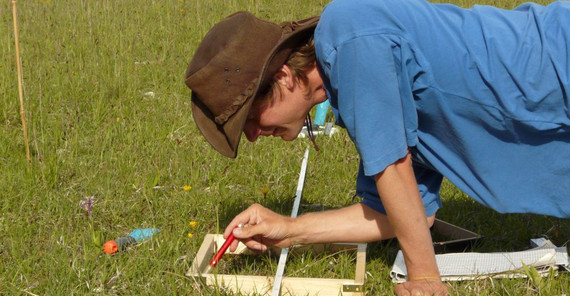What determines the biodiversity of grasslands? Florian Jeltsch and his team have been examining this question for quite some time now. They are interested in the determining factors for grasslands rich in species. Their research concentrates on the nutrient content in specific areas and various types of land-use, mowing and grazing. They have been pursuing their research activities since 2009 in the DFG project “Resilience of grassland plant communities as influenced by root herbivores under different land use intensities”, a sub-project of the DFG Priority Program “Biodiversity Exploratories”.
Florian Jeltsch and his team of biologists, in collaboration with colleagues at the Freie Universität Berlin, have collected data on root herbivores in grasslands to answer this question. They analyze only agricultural-use grassland, i.e. grassland usually used for livestock breeding or hay and silage production. The biologists study “fixed design” plots, which are actually cultivated by farmers, instead of “artificial” ones. This enables them to compare various intensities and types of use. If they are to succeed, the researchers – soil researchers and entomologists – will have to cooperate with local farmers and coordinate their work with them. “The farmers are usually very cooperative and end up becoming experts because they learn a lot about their agricultural area. Due to many years of experience, they also have a comprehensive knowledge about soil and vegetation,” Jeltsch explains.
Little research has been done so far on what happens underground. “Aboveground, you see grass-eating cattle and goats or mown grass, but what happens underground, in the root area?” The root herbivores are an important factor in this context. It is known that they may occur in large numbers and eat a relatively large amount of root. “Their significance for biodiversity is still unclear,” Jeltsch says. The researchers wonder whether the pests act like lawn mowers or rather eat selectively. They also want to establish which types of pests eat selectively, which prefer big roots, which roots are particularly tasty, and what impact such food selection has.
The researchers surmise that the activities of underground larvae and beetles are especially important when the vegetation “above” is severely disturbed, e.g. due to long dry spells, intensive use of herbicide, or flooding. Such phases are important for future diversity and, as a result, for the location as a whole.
The researchers examine many small areas of only a few square meters, which are spread over many meadows. Colleagues from the FU Berlin take soil samples by means of cylinders and analyze the cut samples in the lab. In order to find out if and how many larvae are in the sample, they slowly heat them from top to bottom until the larvae fall out. It is tedious work because the herbivores are unevenly distributed.
As part of the overall DFG project on functional biodiversity research, Jeltsch combines empirical fieldwork, experiments, and computer models to explore how various types of land-use and related disturbances influence the biodiversity of grasslands and determine the role of root herbivores in this process. “We want to understand the interacting mechanisms of land-use, plants, and belowground feed,” Jeltsch explains the project. He assumes that the type and intensity of land-use determine the amount and direction of root herbivores’ influence. In controlled greenhouse experiments they analyze how root herbivores affect the resilience of grassland plant communities. Their empirical fieldwork describes the development of root herbivores and plant communities after disturbances.
Based on their findings on individual, interacting plants, the biologists are preparing a computer model to simulate complete grassland dynamics. “This helps us to understand these processes,” says Jeltsch. The researchers simplify and simulate natural processes. Students trained in biological modeling are developing the corresponding program.
“We have developed a computer model that has not yet existed in a comparable form.” This is why the industrial stakeholders are very interested and hope the model will enable them to better assess the direct and indirect effects of herbicides on grassy areas.
Grasslands, meadows, and pastures are among the systems with the richest biodiversity in Germany, which makes their conservation extremely important. Pests in these systems are also relevant for agrarian economy because they do not stay on the meadows but instead migrate to farmland, inflicting massive damage. “If we better understand these dynamics, we may be able to get a better handle on limiting the damage to the benefit of farmers,” says Jeltsch.
The Researcher
Prof. Florian Jeltsch studied physics in Marburg and earned his doctoral degree with a thesis on theoretical ecology in 1992; he did his habilitation in Jena in 1999. He has been Professor of Plant Ecology and Nature Conservation at the University of Potsdam since 2000 and Spokesperson for the Potsdam Graduate School (PoGS) since 2009.
Contact
Universität Potsdam
Institut für Biochemie und Biologie
Maulbeerallee 3
14469 Potsdam
E-Mail: jeltschuuni-potsdampde
Text: Dr. Barbara Eckardt
Online-Editing: Agnes Bressa
Contact Us: onlineredaktionuuni-potsdampde

